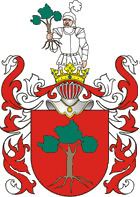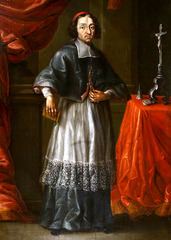Name Stanislaw Dambski | ||
 | ||
Died 15 December 1700Krakow | ||
Stanisław Kazimierz Dąmbski (or Dąbski) (born about 1638; died 15 December 1700 in Kraków), was bishop of Krakow, Kujawy, Płock, Łuck and Chełm, all in Poland.
Contents
Life

Dąmbski was the second son of Adam Dąmbski, hrabia (count) in Lubańiec, castellan of Słońsk (died 1660), and Elżbieta Jemielska of Jemielna. The Dąmbskis, an ancient noble family of Inowrocław and Brzesc Kujawski, used the Godziemba coat of arms.
After graduating from the Krakow Academy, Dąmbski served as secretary to King Michał Korybut Wiśniowiecki. In 1673 Dąmbski became bishop of Chełm, and in 1676 was appointed bishop of Łuck. By 1682 he was bishop of Płock, and in 1692 became bishop of Kujawy.
These ecclesiastic positions provided Dąmbski with immense wealth. He donated to the Wawel Cathedral a monstrance studded with precious stones, which remains in the cathedral treasury. He renovated sumptuously a number of churches, founded the Jesuit school in Toruń, constructed the cathedral in Łuck, and in 1693 built the Dąmbski Palace in Toruń, which features a fine Baroque facade. He also bought the manor of Kaczkowo (including eight villages), in Inowrocław county, in 1670, where he built a summer palace. Between 1679 and 1681, he acquired lands near Iłów comprising one town and 10 villages, in the counties of Gostynin and Sochaczew.
Political life
Dąmbski was an active participant in Poland's political life. When elections to select a new king were held in 1674, Dąmbski was a leader of the anti-French faction, throwing his support to hetman Jan Sobieski, who ascended the throne as Jan III. Jan III died in 1696.
Dąmbski played a key role in the subsequent royal election, which has been described as "one of the most dismal episodes in Polish parliamentary history." Dąmbski initially backed election of the late king's son, Jakub Sobieski. However, Jakub Sobieski was in Silesia at the time of his father's death, and was immediately seized by Saxon troops. Dąmbski became a leader among supporters of the Russian-backed candidate, Friedrich August, Elector of Saxony. Despite enormous bribes paid by the Elector and his backers, the Elector's Protestantism aroused suspicions among the Polish nobles. Although the Elector promised to convert to Roman Catholicism, on 27 June 1697, the Polish nobility elected the French candidate, the Prince de Conti, and the Primate proclaimed Conti king.
Nevertheless, that same evening a group of dissenters—led by Dąmbski—held a second vote. In the absence of the Primate, who had not returned to the election field, Dąmbski proclaimed the Elector to be king. The Elector immediately invaded. On September 15, in the Wawel Cathedral in Krakow, Dąbski crowned the Elector king as August II of Poland. It was the first time that a deceased monarch's son had not been elected to succeed him; that the rightful candidate had been debarred from the throne by military force; and that the Poles had acquired a German king, which went against a long tradition of keeping German hegemony at arm's length." A grateful King August II nominated Dąmbski to be bishop of Krakow on 30 March 1700. However, before Dąmbski could be installed, he died suddenly. He was buried in the Saints Peter and Paul Church, in Krakow.
